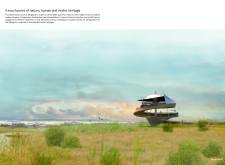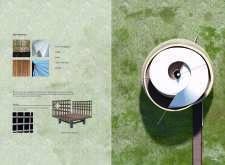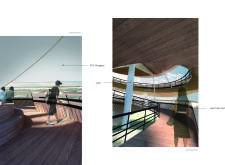5 key facts about this project
The tower's concept revolves around the harmonious blend of modern architectural techniques and traditional design elements. Through a spiral form, visitors are guided to ascend gradually, allowing them to appreciate the wetland from different heights and perspectives. This approach not only facilitates viewing but also engages visitors in a thoughtful exploration of the surrounding ecosystem.
Unique Design Approaches
This project showcases several unique design features that differentiate it from typical observation structures. First, the incorporation of *mashrabiya*, a traditional Arabic architectural element, enhances the aesthetic appeal while providing effective shading and ventilation. The oscillating façade promotes air circulation, significantly improving thermal comfort in the hot climate.
In addition to cultural references, the choice of materials is integral to the tower's sustainability strategy. The use of PTFE fibreglass for the canopy allows for a lightweight yet durable structure that provides protection from the sun. This is complemented by steel for structural support and timber for flooring elements, which adds warmth and comfort to the interior.
Architectural Details
Key architectural elements include multiple observation platforms at varying heights. Each level is thoughtfully designed to cater to different activities, such as quiet observation and group discussions on ecological topics. The landscape surrounding the tower has been minimally disturbed, allowing for an immersive experience with nature.
The overall design promotes a connection with the environment while considering ecological impacts. The project utilizes locally sourced materials, reinforcing its commitment to sustainability. The result is an architecture that not only serves a functional purpose but also embodies the cultural narrative of the region.
For a more detailed understanding of the project's architectural plans, sections, designs, and ideas, readers are encouraged to explore the presentation. This exploration will provide deeper insights into the innovative approaches and architectural solutions implemented in this unique observation tower.


























